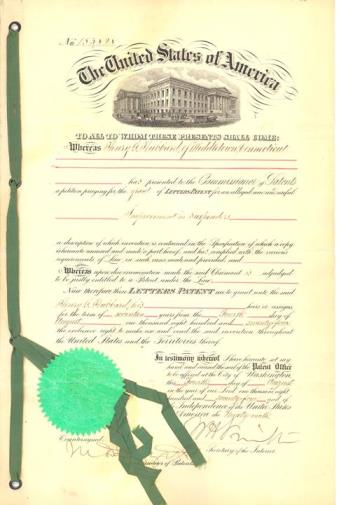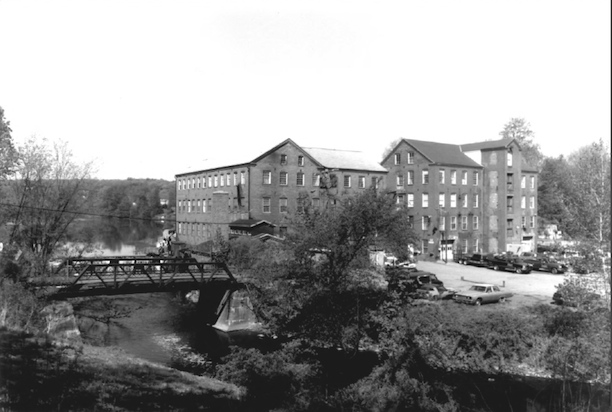By Chien Ho
By examining the impact that the Starr Mill had on the Coginchaug River from the early 19th century to the middle of the 20th century, historians obtain a better understanding of the environmental effects of industrial expansion on local waterways. As industry grew in the 19th century, manufacturers sought to impose their will on nature. During this time, enterprising industrialists and manufacturers began to harness swiftly flowing New England rivers (like the Coginchaug) to power machinery in factories, thus bringing about changes to the local environment; the most important of these were changes to land use along the banks of these rivers as well as changes to the rivers themselves.

1808 Pattern Nathan Starr Cutlass – USS Constitution Museum
Construction of the Starr Mill
After obtaining a substantial war department contract in 1812, Nathan Starr Jr. constructed a brick factory on the land his father purchased in Middletown in 1799. The factory, located on the Coginchaug River, manufactured various kinds of arms, including swords, pistols, and rifles for the government. Production continued until 1845 when the government terminated its contracts. From 1812 to 1845, however, the company managed to produce over 70,000 weapons, including a number of commemorative swords for national war heroes such as Andrew Jackson.

Unidentified soldier in Union uniform holding 1818 Nathan Starr Contract cavalry saber – Library of Congress, Prints and Photographs Division
The Starr Mill relied on the flowing water of the Coginchaug River to power its machinery. In order to harness the flowing water, Nathan Starr constructed a water wheel under his factory and added a dam and several millraces to the river. As the water wheel underneath the factory turned, it converted the flowing water into an energy source that powered the factory’s machinery. The dam regulated the amount of water that entered the water wheel, and millraces (man-made water channels) directed the flow of water to the water wheel. These three additions to the Coginchaug ensured that flowing water remained high and controllable as a power source.
Emergence of Industry in Middletown
Despite the closing of Starr’s business in 1845, the mill property on which it resided continued to contribute to the growth of Middletown. Samuel Russell, who earned financial success in the China trade, shifted his business interests from trade to manufacturing when he founded the Russell Manufacturing Company (Rusco) with Samuel D. Hubbard in 1834. Rusco began with a capital of $200,000, a considerable sum of money for the time, but did not really begin flourishing until Henry G. Hubbard, Samuel Hubbard’s nephew, took over management of the company in 1836. Five years later, Henry Hubbard developed a method for producing elastic webbing on power looms. This innovation enabled Rusco to provide a specialized product, suspenders, to a wide market. As part of its post-Civil War expansion, Rusco bought the Starr Mill property in June of 1864 for $8,000.

Image of Rusco’s Suspender Patent, 1899 – Middletown County Historical Society, Russell Manufacturing Compound Collection
The following year, the company constructed the present-day Starr Mill, Mill A, from the brownstone foundation of the original Starr Mill. Rusco also built a masonry dam that stood 13 feet high and replaced the previous dam. In an effort to expand its Starr Mill site, the company constructed an additional mill, Mill B, as well as four wood-framed tenements in 1870. Rusco then installed a Leffel turbine (a type of water-powered turbine) to accommodate this increase in machinery.
The late nineteenth century, a time of industrial expansion, marked a time of significant change for Middletown residents. Textile industries, like Rusco, employed a large percentage of the local population. As more residents worked in the mills, the demand for homes near the work site increased. Developers transformed more of the land along the banks of the rivers into residential areas. In 1900, Rusco became the country’s largest manufacturer of suspenders. They operated the Starr Mill facility until 1956.
Reflecting Cultural Values of the Period
Tracing the changes in the Starr Mill facility from 1812 to 1956 provides insight into the impact that industry had on Middletown’s environmental landscape, but also tells us much about American attitudes toward industrial expansion and environmental preservation. Imposing their will on natural obstacles to progess, the owners of the Starr Mill modified their landscape without much consideration for the environmental effects of their actions. The two most significant ramifications of this process brought permanent changes to land use along the Coginchaug River, as well as to the natural properties of the river itself.
Chien Ho authored this piece while a student at Wesleyan University as part of a class project in environmental history.









